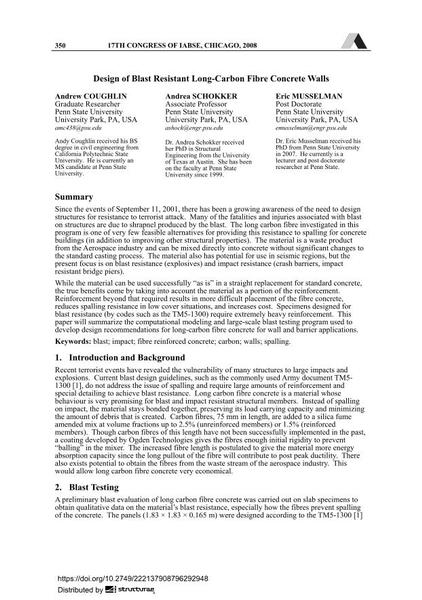Design of Blast Resistant Long-Carbon Fibre Concrete Walls

|
|
|||||||||||
Bibliographic Details
| Author(s): |
Andrew Coughlin
(Graduate Researcher Penn State University University Park, PA, USA)
Eric Musselman (Post Doctorate Researcher Penn State University University Park, PA, USA) Andrea Schokker (Associate Professor Penn State University, University Park, PA, USA) |
||||
|---|---|---|---|---|---|
| Medium: | conference paper | ||||
| Language(s): | English | ||||
| Conference: | 17th IABSE Congress: Creating and Renewing Urban Structures – Tall Buildings, Bridges and Infrastructure, Chicago, USA, 17-19 September 2008 | ||||
| Published in: | IABSE Congress Chicago 2008 | ||||
|
|||||
| Page(s): | 350-351 | ||||
| Total no. of pages: | 7 | ||||
| Year: | 2008 | ||||
| DOI: | 10.2749/222137908796292948 | ||||
| Abstract: |
Since the events of September 11, 2001, there has been a growing awareness of the need to design structures for resistance to terrorist attack. Many of the fatalities and injuries associated with blast on structures are due to shrapnel produced by the blast. The long carbon fibre investigated in this program is one of very few feasible alternatives for providing this resistance to spalling for concrete buildings (in addition to improving other structural properties). The material is a waste product from the Aerospace industry and can be mixed directly into concrete without significant changes to the standard casting process. The material also has potential for use in seismic regions, but the present focus is on blast resistance (explosives) and impact resistance (crash barriers, impact resistant bridge piers). While the material can be used successfully “as is” in a straight replacement for standard concrete, the true benefits come by taking into account the material as a portion of the reinforcement. Reinforcement beyond that required results in more difficult placement of the fibre concrete, reduces spalling resistance in low cover situations, and increases cost. Specimens designed for blast resistance (by codes such as the TM5-1300) require extremely heavy reinforcement. This paper will summarize the computational modeling and large-scale blast testing program used to develop design recommendations for long-carbon fibre concrete for wall and barrier applications. |
||||
| Keywords: |
blast impact spalling fibre reinforced concrete walls carbon
|
||||
